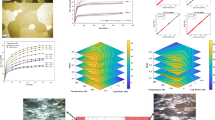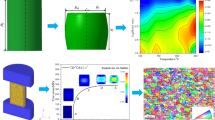Abstract
Isothermal extrusion is an important method for ensuring the quality of extruded profiles. On the basis of the actual indirect extrusion process of 7075 aluminum alloy with high strength and toughness, this study used the combination of a finite element model and deep neural network to construct a prediction model for the temperature series of the indirect extrusion outlet. The extrusion velocity–stroke control curves of the isothermal extrusion of aluminum profiles were obtained on the premise of ensuring maximum production efficiency and the absence of defects. Results showed that the constructed model had high robustness and performed well on the validation set with an average error of 1.8% and that the temperature difference at the outlet of the profile obtained through isothermal extrusion would not exceed 5 °C. By using machine learning, finite element simulation or experiments can be omitted from process optimization, and the indirect isothermal extrusion process can be rapidly optimized. Then, consistency along the extrusion direction was proven by microstructure evolution simulation.














Similar content being viewed by others
Data availability
My manuscript has no associated data or the data will not be deposited.
References
Singh K, Singh H, Vardhan S, Mohan S (2021) Mechanical study of Al 7050 and Al 7075 based metal matrix composites: a review. Mater Today: Proc 43:673–677. https://doi.org/10.1016/j.matpr.2020.12.601
Yoder JK, Griffiths RJ, Yu HZ (2021) Deformation-based additive manufacturing of 7075 aluminum with wrought-like mechanical properties. Mater Des 198. https://doi.org/10.1016/j.matdes.2020.109288
Hua L, Hu X, Han XH (2020) Microstructure evolution of annealed 7075 aluminum alloy and its influence on room-temperature plasticity. Mater Des 196. https://doi.org/10.1016/j.matdes.2020.109192
Li CM, Chen ZQ, Zeng SM, Cheng NP, Chen TX (2013) Intermetallic phase formation and evolution during homogenization and solution in Al-Zn-Mg-Cu alloys. Sci China: Technol Sci 56:2827–2838. https://doi.org/10.1007/s11431-013-5356-5
Lu J, Song YL, Hua L, Zheng KL, Dai DG (2018) Thermal deformation behavior and processing maps of 7075 aluminum alloy sheet based on isothermal uniaxial tensile tests. J Alloys Compd 767:856–869. https://doi.org/10.1016/j.jallcom.2018.07.173
Abdul-Jawwad AK, Bashir A (2011) A comprehensive model for predicting profile exit temperature of industrially extruded 6063 aluminum alloy. Mater Manuf Processes 26:193–201. https://doi.org/10.1080/10426914.2010.505618
Zhang CS, Wang CX, Zhang QY, Zhao GQ, Chen L (2019) Influence of extrusion parameters on microstructure, texture, and second-phase particles in an Al-Mg-Si alloy. J Mater Process Technol 270:323–334. https://doi.org/10.1016/j.jmatprotec.2019.03.014
Chen L, Cheng Q, Tang JW, Li ZQ, Zhao GQ, Zuo Y (2021) Numerical and experimental study on extrusion of ZK60 Mg alloy using billet with temperature gradient. J Mater Res Technol 14:3018–3028. https://doi.org/10.1016/j.jmrt.2021.08.099
Reggiani B, Donati L (2019) Prediction of liquid nitrogen die cooling effect on the extrusion process parameters by means of FE simulations and experimental validation. J Manuf Process 41:231–241. https://doi.org/10.1016/j.jmapro.2019.04.002
Zhou J, Li L, Duszczyk J (2004) Computer simulated and experimentally verified isothermal extrusion of 7075 aluminium through continuous ram speed variation. J Mater Process Technol 146:203–212. https://doi.org/10.1016/j.jmatprotec.2003.10.018
Farjad Bastani A, Aukrust T, Brandal S (2011) Optimisation of flow balance and isothermal extrusion of aluminium using finite-element simulations. J Mater Process Technol 211:650–667. https://doi.org/10.1016/j.jmatprotec.2010.11.021
Yang H, Zhang J, He Y, Han B (2005) Effect of temperature and ram speed on isothermal extrusion for large-size tube with piece-wing. J Mater Sci Technol 21:499–504. https://doi.org/10.3321/j.issn:1005-0302.2005.04.014
Yi J, Liu ZW, Zeng WQ (2021) Isothermal extrusion speed curve design for porthole die of hollow aluminium profile based on PID algorithm and finite element simulations. Trans Nonferrous Met Soc China 31:1939–1950. https://doi.org/10.1016/s1003-6326(21)65628-5
Bai SW, Fang G, Zhou J (2020) Construction of three-dimensional extrusion limit diagram for magnesium alloy using artificial neural network and its validation. J Mater Process Technol 275. https://doi.org/10.1016/j.jmatprotec.2019.116361
Ayer Ö (2019) A forming load analysis for extrusion process of AZ31 magnesium. Trans Nonferrous Met Soc China 29:741–753. https://doi.org/10.1016/s1003-6326(19)64984-8
Bingöl S, Ayer Ö, Altinbalik T (2014) Extrusion load prediction of gear-like profile for different die geometries using ANN and FEM with experimental verification. Int J Adv Maucf Technol 76:983–992. https://doi.org/10.1007/s00170-014-6328-z
Wang LL, Zhou J, Duszczyk J, Katgerman L (2012) Friction in aluminium extrusion—Part 1: A review of friction testing techniques for aluminium extrusion. Tribol Int 56:89–98. https://doi.org/10.1016/j.triboint.2012.01.012
Ghosh A, Ghosh M (2018) Microstructure and texture development of 7075 alloy during homogenisation. Philos Mag 98:1470–1490. https://doi.org/10.1080/14786435.2018.1439596
Box GEP, Jenkins GM (2010) Time series analysis : forecasting and control. J Time 31.https://doi.org/10.1111/j.1467-9892.2009.00643.x
Vaswani A, Shazeer N, Parmar N, Uszkoreit J, Jones L, Gomez AN, Kaiser Ł, Polosukhin I (2017) Attention is all you need. Adv Neural Inf Process Syst 30
Wen QS, Zhou T, Zhang CL, Chen WQ, Ma ZQ, Yan JC, Sun L (2022) Transformers in time series: a survey. arXiv preprint arXiv 07125. https://doi.org/10.48550/arXiv.2202.07125
Parmeazn ARS, Souza VMA, Batista GEAPA (2019) Evaluation of statistical and machine learning models for time series prediction: identifying the state-of-the-art and the best conditions for the use of each model. Inf Sci 484:302–337. https://doi.org/10.1016/j.ins.2019.01.076
Lim B, Arık SÖ, Loeff N, Pfister T (2021) Temporal fusion transformers for interpretable multi-horizon time series forecasting. Int J Forecast 37:1748–1764. https://doi.org/10.1016/j.ijforecast.2021.03.012
Shekhar S, Bansode A, Salim A (2022) A comparative study of hyper-parameter optimization tools. 2021 IEEE Asia-Pacific Conf Comput Sci Data Eng 1–6. https://doi.org/10.1109/CSDE53843.2021.9718485
Ang KH, Chong G, Li Y (2005) PID control system analysis, design, and technology. IEEE Tran Con Syst Tech 13(4):559–576. https://doi.org/10.1109/TCST.2005.847331
Quan GZ, Mao YP, Li GS, Lv WQ, Wang Y, Zhou J (2012) A characterization for the dynamic recrystallization kinetics of as-extruded 7075 aluminum alloy based on true stress–strain curves. Comput Mater Sci 55:65–72. https://doi.org/10.1016/j.commatsci.2011.11.031
Funding
This work was supported by the National Natural Science Foundation of China (52063017), Major science and technology projects of Gansu Province (20ZD7GJ008), and the Young Doctoral Fund of Institutions of Higher Learning of Gansu Province (2022QB-049).
Author information
Authors and Affiliations
Contributions
All authors contributed to the study conception and design. Material preparation, data collection, and analysis were performed by Ce Guo, Jisen Qiao, and Qilun Li. The first draft of the manuscript was written by Ce Guo and all authors commented on previous versions of the manuscript. All authors read and approved the final manuscript.
Corresponding author
Ethics declarations
Competing interests
The authors declare no competing interests.
Additional information
Publisher's note
Springer Nature remains neutral with regard to jurisdictional claims in published maps and institutional affiliations.
Rights and permissions
Springer Nature or its licensor (e.g. a society or other partner) holds exclusive rights to this article under a publishing agreement with the author(s) or other rightsholder(s); author self-archiving of the accepted manuscript version of this article is solely governed by the terms of such publishing agreement and applicable law.
About this article
Cite this article
Guo, C., Qiao, J., Wang, W. et al. Optimization strategy for the indirect isothermal extrusion of high-strength aluminum alloy based on temporal fusion transformer. Int J Adv Manuf Technol 126, 5179–5189 (2023). https://doi.org/10.1007/s00170-023-11370-9
Received:
Accepted:
Published:
Issue Date:
DOI: https://doi.org/10.1007/s00170-023-11370-9




